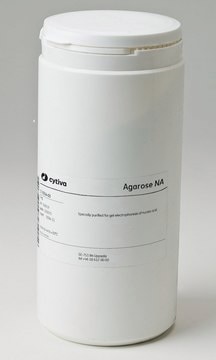Products may be shipped at a different temperature than the recommended long-term storage temperature. If the product quality is sensitive to short-term exposure to conditions other than the recommended long-term storage, it will be shipped on wet or dry-ice. If the product quality is NOT affected by short-term exposure to conditions other than the recommended long-term storage, it will be shipped at ambient temperature. As shipping routes are configured for minimum transit times, shipping at ambient temperature helps control shipping costs for our customers. For more information, please refer to the Storage and Transport Conditions document: https://www.sigmaaldrich.com/deepweb/assets/sigmaaldrich/marketing/global/documents/316/622/storage-transport-conditions-mk.pdf
A9414
Agarose, low gelling temperature
BioReagent, for molecular biology
Synonym(s):
3,6-Anhydro-α-L-galacto-β-D-galactan, LMP agarose, 2-Hydroxyethyl agarose
Select a Size
Select a Size
About This Item
Recommended Products
biological source
algae (red)
Quality Level
grade
for molecular biology
product line
BioReagent
form
powder
EEO
≤0.10
mp
≤65 °C
transition temp
congealing temperature 26-30 °C
gel strength
≥200 g/cm2 (1% gel)
anion traces
sulfate (SO42-): ≤0.10%
suitability
suitable for electrophoresis
suitable for molecular biology
foreign activity
DNase, RNase, NICKase, none detected
SMILES string
O1[C@H]([C@@H]([C@H]([C@H]([C@H]1CO)O)O[C@@H]4O[C@@H]5[C@H]([C@@H](OC5)[C@@H]4O)O[C@@H]6O[C@@H]([C@@H]([C@@H]([C@H]6O)O)O)CO)O)O[C@H]2[C@H]3OC[C@@H]2O[C@H]([C@H]3O)O
InChI key
MJQHZNBUODTQTK-WKGBVCLCSA-N
General description
Application
- for gel electrophoresis, low melting temperature is ideal for DNA extraction from gel -gel scaffold material for tissue engineering using BMSCs[1]
- to embed tissues in 5% agarose for immunohistology[2]
- for preparation of collagen-agarose co-gels to study collagen-matrix interactions in soft tissues[3]
- single-celled gel electrophoresis (comet assay)[4]
- for in-vivo 3-D imaging of zebrafish larvae immobilized on agarose strips[5]
Features and Benefits
- BioReagent suitable for gel electrophoresis
- Band separation range: 200 bp - 25 kB - low gelling temperature is ideal for cell culture and viral plaque assays
- low melting point (LMP) gel is compatible with several DNA recovery methods: phenol/chloroform extractions, recovery columns, electroelution, Beta-Agarase, and freeze/squeeze
- Guaranteed quality tested for use in molecular biology, free of DNase and RNase
Analysis Note
Sulfate content - used as an indicator of purity, since sulfate is the major ionic group present.
Gel strength - the force that must be applied to a gel to cause it to fracture.
Gel point - the temperature at which an aqueous agarose solution forms a gel as it cools. Agarose solutions exhibit hysteresis in the liquid-to-gel transition - that is, their gel point is not the same as their melting temperature.
Electroendosmosis (EEO) - a movement of liquid through the gel. Anionic groups in an agarose gel are affixed to the matrix and cannot move, but dissociable counter cations can migrate toward the cathode in the matrix, giving rise to EEO. Since electrophoretic movement of biopolymers is usually toward the anode, EEO can disrupt separations because of internal convection.
Other Notes
Storage Class
11 - Combustible Solids
wgk_germany
WGK 3
flash_point_f
Not applicable
flash_point_c
Not applicable
ppe
Eyeshields, Gloves, type N95 (US)
Choose from one of the most recent versions:
Certificates of Analysis (COA)
Don't see the Right Version?
If you require a particular version, you can look up a specific certificate by the Lot or Batch number.
Already Own This Product?
Find documentation for the products that you have recently purchased in the Document Library.
Customers Also Viewed
-
How is shipping temperature determined? And how is it related to the product storage temperature?
1 answer-
Helpful?
-
-
How can I determine the shelf life / expiration / retest date of this product?
1 answer-
If this product has an expiration or retest date, it will be shown on the Certificate of Analysis (COA, CofA). If there is no retest or expiration date listed on the product's COA, we do not have suitable stability data to determine a shelf life. For these products, the only date on the COA will be the release date; a retest, expiration, or use-by-date will not be displayed.
For all products, we recommend handling per defined conditions as printed in our product literature and website product descriptions. We recommend that products should be routinely inspected by customers to ensure they perform as expected.
For products without retest or expiration dates, our standard warranty of 1 year from the date of shipment is applicable.
For more information, please refer to the Product Dating Information document: https://www.sigmaaldrich.com/deepweb/assets/sigmaaldrich/marketing/global/documents/449/386/product-dating-information-mk.pdfHelpful?
-
Active Filters
Our team of scientists has experience in all areas of research including Life Science, Material Science, Chemical Synthesis, Chromatography, Analytical and many others.
Contact Technical Service

